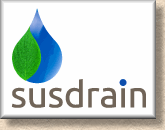Introduction:
Over the last decade, it's becoming increasingly difficult to read or write anything about any aspect of paving or drainage design and construction without involving the mysterious term SUDS somewhere in the text. It's on the periphery of many peoples' understanding of the hard-landscaping trade, but many in the trade, and most of those from outside, have little or no understanding of what it means and why it's suddenly become so important.
SUDS is Sustainable Urban Drainage Systems, but then some say it is Sustainable Drainage Schemes, or Sustainable Drainage Systems. Whatever: the key point is that it is sustainable drainage - a series of methods for dealing with drainage in a sustainable manner, using technologies that minimise the environmental impact of our lifestyles, buildings, structures and surfaces. In simple terms, it's a re-think of what we, as a society, do with all the surface run-off, grey water, effluent and sewage we produce.
The Rules
Over recent years in Britain, there has been a subtle change in the rules and regulations that cover the general principles behind surface water drainage. The two most directly relevant publications are...
Building Regulations Part H3
Updated to emphasise the requirement to deal with surface water at source (source control) rather than dumping it into existing sewer systems.
Planning Policy GuidanceNote 25 (PPG25)
Government requirement that "all new developments should collect, treat and ideally re-use storm water where it falls"
The Reasoning
There's been a gradual realisation that we can't keep sending everything we're not sure about to expensive Effluent Treatment Works (ETWs) and dumping all the collected rainwater directly into our streams and rivers. ETWs represent massive long-term investment with significant lead times and can be difficult to site, especially in smaller communities. The ones we have are struggling to cope with all the shi... stuff we dump on them, to coin a phrase, and a significant proportion of the effluent treated doesn't actually need all that expensive flocculation, sedimentation and filtering.
When it comes to surface water, the run-off from roofs and pavements, this is reasonably clean and really doesn't need cleaning-up before being returned to the environment. There'll be some sediment picked up from the roof or the paving, and there could well be some contaminants, such as oils from leaky engines, but by and large, it's not that bad. Obviously, the roofs and pavements being drained will have a direct effect on the 'quality' of the surface water: gritty or sandy surfaces may have an elevated sediment content, and run-off from a busy highway is likely to contain more contaminants than run-off from a patio or driveway, but relatively simple techniques can be used to 'trap' sediment and contaminants before the water is released.
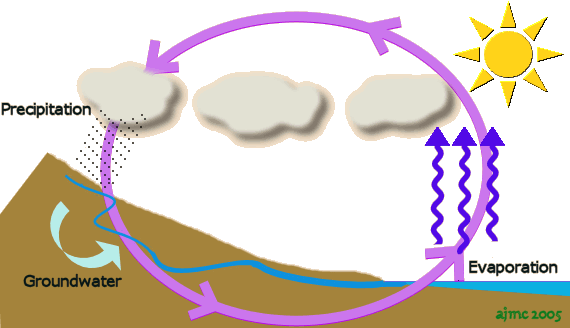
Recent experiences with winter flooding, summer droughts worsened by over-abstraction from aquifers for potable water to supply our communities, and increased levels of building on natural flood plains, have brought us to the realisation that by collecting water from hardscapes (roofs and pavements) and then channelling it via underground pipes to a suitable stream, lake or river, we're actually exacerbating the problem. This 'traditional' system accelerates the hydrological cycle; dramatically reducing the time between a raindrop hitting the ground (or roof) and it entering a watercourse that will eventually lead back to the sea, and reducing the storage capacity of the system by artificially diverting water and by-passing the partially-emptied aquifers.
In an undeveloped environment, the raindrop soaks into the ground where it lands, and travels through the underlying strata, being naturally filtered during its passage, and eventually joining the body of "groundwater" at the water table. There's a natural flow regime within the groundwater that results in the aquifers, the water-bearing rock layers, being recharged (topped-up). The cycle is slowed down or "attenuated" and the storage capacity of the system as a whole is massively increased.
A typical SUDS application for surface water often uses the ground as a 'channel' for the collected water which significantly 'slows down' the flow as well as providing a much greater storage capacity.
In contrast, a traditional piped solution provides very little storage and usually discharges the collected water to a watercourse as rapidly as possible.
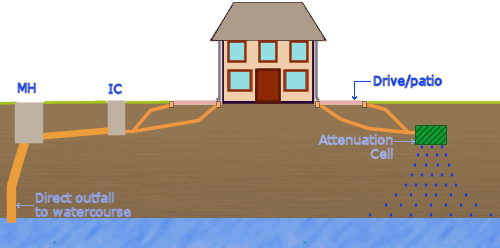
In essence, SUDS applications seek to use the natural environment as a conduit for collected water, mimicking what would happen if us pesky humans hadn't messed up everything with our buildings and pavements.
Benefits
The benefits of SUDS are numerous, but key pluses are:
- Flood control and better management of storm water at source (source control)
- Pollution control
- Recharging of groundwater regimes and aquifers
- Reduced construction and maintenance costs
- Improved environment
Technologies
There are dozens, if not hundreds of different SUDS applications, ranging from reed-bed treatment systems for polluted water, to settlement ponds for sediment, to simple swales and filter drains. Schemes are usually site-specific, taking a range of core technologies and using them either singly or in combination to create and application that deals with the surface water drainage for a particular site.
The core technologies involved include:
- Permeable Paving
- Infiltration and attenuation systems (Including soakaways)
- Filter drains
- Swales
- Rain Gardens
- Ponds and Wetlands
Permeable Pavements
Permeable or porous paving systems defy conventional construction thinking which, for more than 2,000 years, has focussed on getting surface water off and away from the pavement structure as rapidly as possible. The surface water is actually directed into the pavement and then stored or released into the environment in a controlled manner. Most permeable and porous pavements use some form of block paving to create the surface layer, but there are emerging technologies that enable bitmac/asphalt and resinous surfacing to be used. Permeable block paving systems are considered on a separate page .
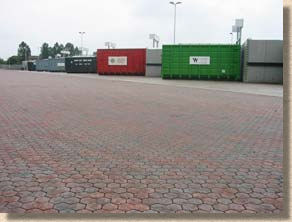
Infiltration and Attenuation
Theis group includes soakaways , which are probably the most popular form of SUDS when used in conjunction with paving.
Infiltration and attenuation systems function by gradually returning the collected surface water to the environment. They may include a storage element that allows sudden surges of water (such as short, heavy downpours) to be 'stockpiled' and then released to the environment over an extended period. These are, in effect, modern soakaways.
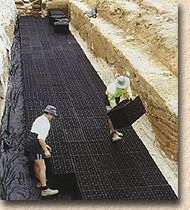
Filter Drains
Filter drains of one form or another have been with us for hundreds of years. Traditional 'land', 'french', or 'field' drains are a form of filter drain. They direct water to (or collect water from) an extended area and could be thought of as linear soakaways. A modern filter drain construction is somewhat more advanced than the butt-jointed line of pipe or land-tiles buried in the ground that have been used in the past.
See also....
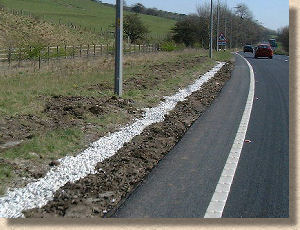
Swales
Swales are basically 'part-time ditches'. They are typically relatively broad yet shallow channels cut into the ground and are most commonly found at the edges of roads, or close by. Surface water is directed into the swale where it flows along to a suitable storage or outfall point, and may gradually soak into the ground beneath. Unlike normal drainage ditches that tend to contain running water most of the time, swales are intended to be dry(ish) for long periods, and so they are often smothered with vegetation that doesn't mind being inundated occasionally.
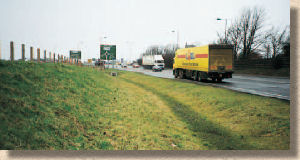
There is much more information about Swales, and many other forms of SUDS applications, on the SusDrain website
Rain Gardens
A rain garden is essentially a patch of a garden given over to water-loving planting. They can be as big or as small as desired, but when a rain garden is used as a suds infiltration solution for typical residential driveways or patios, they tend to be roughly 1m² to 10m² in area.
Like soakaways, they are best positioned at least 5m from any building or structural wall, but they are, sometimes, located directly beneath downspouts to facilitate roof run-off.
They tend to be slightly lower than the surrounding area, maybe by only 100-200mm or so, and function best when the topsoil is free-draining loam, so that when inundated with water, the rain garden ‘patch’ facilitates infiltration to the sub-layers/sub-soil.
Typically, they will be planted with attractive native species that thrive in conditions that are subject to irregular inundation or are near permanent damp.
There is much more information about Rain Gardens, and many other forms of SUDS applications, on the SusDrain website
Ponds and wetlands
Settlement or balancing ponds, basins and wetlands are specially constructed features that provide storage, allow sediments to be trapped, provide an eco-system that than 'clean up' collected water, while allowing a degree of infiltration and providing a more attractive and bio-diverse environment. Existing ponds, basins and wetlands are rarely suitable for all sorts of reasons, not least of which is disturbance of the natural balance that has evolved within that system, and so SUDS ponds/wetlands are generally 'new' constructions.
Summary:
Further Reading:

SUDSnet - UK-wide network for researchers, practitioners, agencies, developers and all interested parties

Environment Agency - England and Wales

CIRIA - Leading Construction innovation and research body with dedicated SUDS mini-site

Urban Water Technology Centre - Specialist department within Abertay University

SNIFFER - Scottish and Northern Ireland Forum For Environmental Research

